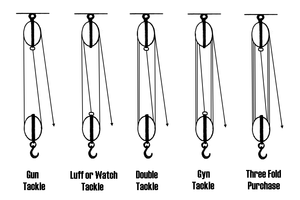Pioneering

In the Scout Movement, pioneering is the art of using ropes and wooden spars joined by lashings and knots to create a structure. Pioneering can be used for constructing small items such as camp gadgets up to larger structures such as bridges and towers. These may be recreational, decorative, or functional.
Pioneering is used to teach practical skills, teamwork and problem solving. It is widely used in Scouting and Girl Guiding. Many Scout and Guide groups train their members in pioneering skills and construct projects, both small and large. In camp, Scouts may construct functional items like tables, camp dressers and gadgets, as well as decorative camp gateways. Pioneering is a common merit badge in many countries, and was required for the Eagle Scout rank in the 1920s and 1930s.
The name comes from the 18th and 19th century military engineers who went ahead of an army to "pioneer" a route, which could involve building bridges and towers with rope and timber (for example the Royal Pioneer Corps).
Pioneering skills include knot tying (tying ropes together), lashing (tying spars together with rope), whipping (binding the end of a rope with thin twine), splicing (joining or binding the end of a rope using its own fibres), and skills related to the use, care and storage of ropes, spars and related pioneering equipment.
Source: ((Scouting) - Wikipedia)
Animated Knots
AnimatedKnots.com is a great resource to learn how to do knots, lashings, splices and whippings.
Knots and ropes
The six basic knots and hitches for Scouts are: Reef knot, Sheepshank, Bowline, Clove hitch, Sheet bend, Round turn and two half-hitches.
- Basic Knots
- Six Basic Knots
- More knots (Pro-plan 2)
- Knots and knotting
- See the knots category for more
Different types of rope (hawser-laid, shroud-laid and cable laid), and how to store and care for them.
Whipping
To prevent a rope from fraying, the ends must be whipped. These documents explain the Simple whipping, West Country whipping and Sailmaker's whipping.
Splicing
Splices are used to join any two parts of rope together permanently. This document explains the Back splice, Eye splice, Short splice and Docker splice.
Lashings

- Square Lashing (Pro-plan 3)
- Lashings (1)
- Lashings (2)
- More Lashings (Pro Plan Chart 4)
- Japanese Square Lashing (Pro Plan Chart 5)
- Diagonal Lashing (Pro Plan Chart 6)
Simple projects
- Pioneering Projects (Pioneering Pro-plan 21 )
- The Trestle (Pro-plan 10)
- Flagpoles (Pioneering Pro-plan 6)
- Pioneering Projects - Javelin Thrower (Pioneering Pro-plan 7)
- Pioneering Projects - The Giraffe (Pioneering Pro-plan 8)
- Pioneering Projects - Newmarket Ballista (Pioneering Pro-plan 11)
- Pioneering Projects - Guided Missile (Pioneering Pro-plan 12)
- Getting over / transporter (Pioneering Pro-plan 13)
- Basher (Pioneering Pro-plan 14)
Larger projects
For larger projects, you will often need to anchor your project, and use Block and Tackle to lift or maintain tension.

Here are some large project ideas:
- Pioneering projects
- Swinging Derrick
- Monkey bridge
- Roman Ballista
- Bush Bridge (Pro-plan 11)
- Stilt tower
- Brynbach tower
- Abington Spring Bridge
- Hourglass Tower
- Swing Boat